


22/01/2014
NEWS STORY
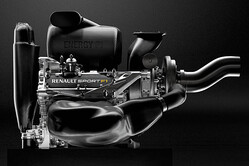 In a year of seismic changes to F1, one of the biggest is the return of the turbo, Renault, ever a leader in engine development gives an insight to its F1-2014 powerunit.
In a year of seismic changes to F1, one of the biggest is the return of the turbo, Renault, ever a leader in engine development gives an insight to its F1-2014 powerunit.
This year, the Formula One World Championship is set for a raft of radical technical regulation changes. From 2014 onwards, the cars will be powered by avant-garde powertrain technology, with a powerful turbocharged internal combustion engine coupled to sophisticated energy recovery systems.
Energy efficiency will reach levels never seen in the sport before, with two types of energy propelling the cars. The internal combustion engine will produce power through consumption of traditional carbon-based fuel, while electrical energy will be harvested from exhaust and braking by two motor generator units. The two systems will work in harmony, with teams and drivers balancing the use of the two types of energy throughout the race.
The advent of this new technology means that the word 'engine' is no longer sufficient: instead the sport will refer to 'Power Units.'
"Renault is fully prepared for this technical revolution, with its Energy F1-2014 Power Unit designed and developed at Viry-Chatillon ready for track testing," says Jean-Michel Jalinier, President of Renault Sport F1. "'Grand Prix racing is a pioneering sport, representing the pinnacle of human endeavour and technological innovation. From the rear mounted engines of the 1930s to the ground effect of the 1980s, F1 technology has always been years ahead of its time. With cutting-edge energy systems and highly advanced turbocharged combustion engines, in 2014 F1 remains true to its DNA. We are absolutely at the vanguard of powertrain technology this year.'
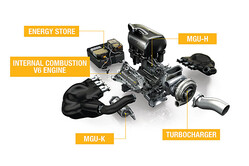 Internal Combustion V6 Engine
Internal Combustion V6 Engine
In short: V6 is shorthand for an internal combustion engine with its cylinders arranged in two banks of 3 cylinders arranged in a 'V' configuration over a common crankshaft. The Renault Energy F1 V6 has a displacement of 1.6 litres and will make around 600bhp, or more than 3 times the power of a Clio RS.
The challenge: Contrary to popular belief, the ICE is not the easiest part of the Power Unit to design as the architecture is very different to the incumbent V8s. On account of the turbocharger the pressures within the combustion chamber are enormous - almost twice as much as the V8. The crankshaft and pistons will be subject to massive stresses and the pressure within the combustion chamber may rise to 200bar, or over 200 times ambient pressure.
One to watch: The pressure generated by the turbocharger may produce a 'knocking' within the combustion chamber that is very difficult to control or predict. Should this destructive phenomenon occur, the engine will be destroyed immediately.
Direct Fuel Injection
In short: All Power Units must have direct fuel injection (DI), where fuel is sprayed directly into the combustion chamber rather than into the inlet port upstream of the inlet valves. The fuel-air mixture is formed within the cylinder, so great precision is required in metering and directing the fuel from the injector nozzle. This is a key sub-system at the heart of the fuel efficiency and power delivery of the power unit.
The challenge: One of the central design choices of the ICE was whether to make the DI top mounted (where the fuel is sprayed at the top of the combustion chamber close to the spark plug) or side mounted (lower down the chamber).
One to watch: The option still remains to cut cylinders to improve efficiency and driveability through corners.
Turbocharger
In short: A turbocharger uses exhaust gas energy to increase the density of the engine intake air and therefore produce more power. Similar to the principle employed on road cars, the turbocharger allows a smaller engine to make much more power than its size would normally permit. The exhaust energy is converted to mechanical shaft power by an exhaust turbine. The mechanical power from the turbine is then used to drive the compressor, and also the MGU-H (see below).
The challenge: At its fastest point the turbocharger is rotating at 100,000 revolutions per minute, or over 1,500 times per second, so the pressures and temperatures generated will be enormous. Some of the energy recovered from the exhaust will be passed on to the MGU-H and converted to electrical energy that will be stored and can later be re-deployed to prevent the turbo slowing too much under braking.
One to watch: As the turbocharger speed must vary to match the requirement of the engine, there may be a delay in torque response, known as turbo lag, when the driver gets on the throttle after a period of sustained braking. One of the great challenges of the new power unit is to reduce this to near zero to match the instant torque delivery of the V8 engines.
Wastegate
In short: On conventional turbo engines, a wastegate is used in association with a turbocharger to control the high rotation speeds of the system. It is a control device that allows excess exhaust gas to by-pass the turbine and match the power produced by the turbine to that needed by the compressor to supply the air required by the engine. On the Renault Energy F1, the turbo rotation speed is primarily controlled by the MGU-H (see below) however a wastegate is needed to keep full control in any circumstance (quick transient or MGU-H deactivation).
The challenge: The wastegate is linked to the turbocharger but sits in a very crowded area of the car. The challenge is therefore to make it robust enough to withstand the enormous pressures while small enough to fit.
One to watch: On a plane there are certain parts that are classified as critical if they fail. By this measure the wastegate is the same: if it fails the consequences will be very serious.
MGU-K
In short: The MGU-K is connected to the crankshaft of the internal combustion engine. Under braking, the MGU-K operates as a generator, recovering some of the kinetic energy dissipated during braking. It converts this into electricity that can be deployed throughout the lap (limited to 120 kW or 160bhp by the rules). Under acceleration, the MGU-K is powered from the Energy Store and/or from the MGU-H and acts as a motor to propel the car.
The challenge: Whilst in 2013 a failure of KERS would cost about 0.3s per lap at about half the races, the consequences of a MGU-K failure in 2014 would be far more serious, leaving the car propelled only by the internal combustion engine and effectively uncompetitive.
One to watch: Thermal behaviour is a massive issue as the MGU-K will generate three times as much heat as the V8 KERS unit.
MGU-H
In short: The MGU-H is connected to the turbocharger. Acting as a generator, it absorbs power from the turbine shaft to convert heat energy from the exhaust gases. The electrical energy can be either directed to the MGU-K or to the battery for storage for later use. The MGU-H is also used to control the speed of the turbocharger to match the air requirement of the engine (eg. to slow it down in place of a wastegate or to accelerate it to compensate for turbo lag.)
The challenge: The MGU-H produces alternative current, but the battery is continuous current so a highly complex convertor is needed.
One to watch: Very high rotational speeds are a challenge as the MGU-H is coupled to a turbocharger spinning at speeds of up to 100,000rpm.
Battery (or Energy Store)
In short: Heat and Kinetic Energy recovered can be consumed immediately if required, or used to charge the Energy Store, or battery. The stored energy can be used to propel the car with the MGU-K or to accelerate the turbocharger with the MGU-H. Compared to 2013 KERS, the ERS of the 2014 power unit will have twice the power (120 kW vs 60 kW) and the energy contributing to performance is ten times greater.
The challenge: The battery has a minimum weight of 20kg to power a motor that produces 120kW. Each 1kg feeds 6kw (a huge power to weight ratio), which will produce large electromagnetic forces.
One to watch: The electromagnetic forces can impact the accuracy of sensors, which are particularly sensitive. Balancing the forces is like trying to carry a house of cards in a storm - a delicate and risky operation.
Intercooler
In short: The intercooler is used to cool the engine intake air after it has been compressed by the turbocharger.
The challenge: The presence of an intercooler (absent in the normally aspirated V8 engines), coupled with the increase in power from the energy recovery systems makes for a complicated integration process since the total surface area of the cooling system and radiators has significantly increased over 2013.
One to watch: Integration of the intercooler and other radiators is key but effective cooling without incorporating giant radiators is a major challenge and key performance factor.
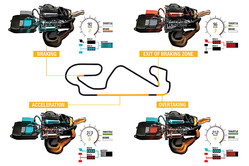 How It All Fits Together
How It All Fits Together
Standard Lap
Under acceleration (eg. down the pit straight) the internal combustion engine will be using its reserve of fuel. The turbocharger will be rotating at maximum speed (100,000rpm). The MGU-H, acting as a generator, will recover energy from the exhaust and pass to the MGU-K (or the battery in case it needs recharging). The MGU-K, which is connected to the crankshaft of the ICE, will act as a motor and deliver additional power to pull harder or save fuel, dependent on the chosen strategy.
At the end of the straight the driver lifts off for braking for a corner. At this point the MGU-K converts to a generator and recovers energy dissipated in the braking event, which will be stored in the battery.
Under braking the rotational speed of the turbo drops due to the lack of energy in the exhaust which, on traditional engines, leads to the curse of the turbo engine - turbo lag. This phenomenon occurs when the driver re-accelerates: Fuel injection starts again and generates hot exhaust gases which speed up the turbo, but it needs time to return to full
rotational speed where the engine produces 100% of its power. To prevent this lag, the MGU-H acts as a motor for a very short time to instantaneously accelerate the turbo to its optimal speed, offering the driver perfect driveability.
Over the course of the lap, this balance between energy harvesting, energy deployment and (carbon) fuel burn will be carefully monitored. "The use of the two types of energy needs an intelligent management," explains Technical Director for new generation Power Units, Naoki Tokunaga. "Electrical energy management will be just as important as fuel management. The energy management system ostensibly decides when and how much fuel to take out of the tank and when and how much energy to take out or put back in to the battery.
"The overall objective is to minimize the time going round a lap of the circuit for a given energy budget. Obviously, if you use less energy, you will have a slower lap time. That's fine. However, what is not fine is to be penalised more than the physics determines necessary. In the relationship between fuel used versus lap time, there is a borderline between what is physically possible and the impossible - we name it 'minimum lap-time frontier'.
"We always want to operate on that frontier and be as close to the impossible as we can. The strategy is subject its own limits, namely the capacity of the PU components and the Technical Regulations. The power output of the engine subject to its own limits, plus MGU-K power and the energy the battery can deliver to it are all restricted by the rules. It is a complex problem. The solution is therefore determined by mathematical modelling and optimisation - we call it 'power scheduling'.
"As a result, there will be a complex exchange of energy going on between the components in the system network, at varying levels of power over a lap. This is completely invisible to the driver as it is all controlled electronically by the control systems. The driver will be able to feel it but no driver intervention is normally required, so they can concentrate on the race in hand. Of course, there will be certain driver-operated modes to allow him to override the control system, for example to receive full power for overtaking. Using this mode will naturally depend on the race strategy. In theory you can deploy as many times as you want, but if you use more fuel or more electrical energy then you have to recover afterwards. The 'full boost' can be sustained for one to two laps but it cannot be maintained."
The fact that the driver does not control the balance between fuel and energy does not lessen the involvement of the driver in any way, and in fact his job will be more complicated than in previous seasons. He will still be fighting the car to keep it under control during hard braking, managing braking to avoid understeer into a corner, applying delicate control over the throttle pedal mid-corner, sweeping through complex corners, throwing the car into high speed corners. In terms of driving style, there may well need to be some adjustments.
"The throttle response will be different so the driver will need to readjust for this," Tokunaga explains. "Effectively, once the driver applies full throttle, the control systems manage the power of PU, with the aim to minimise the time within the given energy. However full throttle no longer means a demand for full engine power. It is an indication to the PU given by the driver to go as fast as possible with the given energy. He will still need to adjust for the different 'feel' of the car with the energy systems."
Race strategy and race management will also be more flexible than in the past and the optimum solution will vary vastly from circuit to circuit, dependent on factors including percentage of wide open throttle, cornering speeds and the aerodynamic configuration of the car.
"In essence, engine manufacturers used to compete on reaching record levels of power, but now will compete in the intelligence of energy management," Tokunaga summises.
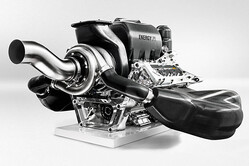 Qualifying - Flat Out, As Always
Qualifying - Flat Out, As Always
In 2014, the fastest car on a Saturday will still start on pole since the sessions will be run 'flat out'. The cars will still be limited by the fundamental fuel flow restriction of 100kg/h but the 100kg fuel limit will be irrelevant since very little fuel is burned over one lap. The driver will therefore be able to use 100% of the allowed fuel flow and the entire energy budget from the battery store for his qualifying lap. However, should he choose to use all the energy on one lap, he will not be able to complete two flat out timed laps and will instead have to wait until the store recharges. This will lead to some even tenser sessions and a number of different strategic calls.
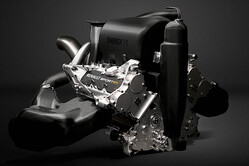 Renault Energy F1-2014 Technical Specification
Renault Energy F1-2014 Technical Specification
Energy F1-2014
Displacement: 1.6L V6
Number of cylinders: 6
Rev limit: 15,000rpm
Pressure charging: Single turbocharger, unlimited boost pressure (typical maximum 3.5 bar abs due to fuel flow limit)
Fuel flow limit: 100 kg/hr (-40% from V8)
Permitted Fuel quantity per race: 100 kg (-35% from V8)
Configuration: 90° V6
Bore: 80mm
Stroke: 53mm
Crank height: 90mm
Number of valves: 4 per cylinder, 24
Exhausts: Single exhaust outlet, from turbine on car centre line
Fuel: Direct fuel injection
Energy Recovery Systems
MGU-K rpm: Max 50,000rpm
MGU-K power: Max 120kW
Energy recovered by MGU-K: Max 2MJ/lap
Energy released by MGU-K: Max 4 MJ/lap
MGU-H rpm: }100,000rpm
Energy recovered by MGU-H: Unlimited (} 2MJ/lap)
Weight: Min 145 kg
Number of Power Units permitted per driver per year: 5
Total horsepower: 600hp (ICE) + 160hp (ERS)